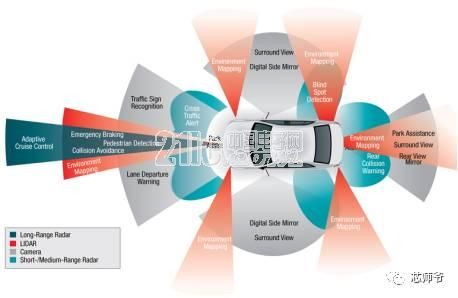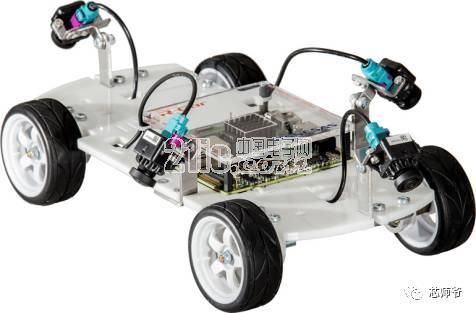Cars have become a key battleground for semiconductor manufacturers. Don't underestimate the complexity of a car—by 2020, it was estimated that a vehicle could contain over a thousand chips. Today, we explore the latest advancements in automotive electronics, focusing on sensors, software, in-vehicle communication, and user interfaces. Let’s dive into what’s new with the help of our car electronics expert.
A wide range of innovations are shaping the automotive industry, from improved power systems to complex telematics and autonomous driving technologies. Modern vehicles are packed with more electronics than ever before. As features like Advanced Driver Assistance Systems (ADAS) become standard, more advanced modules are now accessible to everyday consumers.
Many changes are quietly taking place, driven by improvements in sensors, processors, memory, software, and even human-machine interfaces that require real-time integration (see Figure 1). Here are some of the most recent developments and how they interact with other technologies to enhance their importance in automotive applications.

**1. Advancements in Vehicle Sensors**
Automotive applications are benefiting from high-resolution cameras capable of streaming 4K video. Combined with AI-powered machine learning (ML) software, these cameras are used for obstacle detection and object recognition in advanced ADAS systems. High resolution is essential for both safety and convenience, such as in backup cameras.
Multiple camera setups can create a 360-degree view around the vehicle. For example, Renesas’ R-Car Development Kit combines video from four cameras to offer a bird’s-eye view, which is especially useful when parking or navigating tight spaces. More advanced ADAS systems can detect potential conflicts in real time.

Recent progress has also been made in range sensors like LiDAR and phased array radar. While not new, these technologies are becoming smaller and more affordable, making them more viable for mass-market vehicles.
Companies like Innoviz, LeddarTech, Quanergy, and Velodyne are offering compact 3D solid-state LiDAR systems suitable for use in robots and cars. These systems can be integrated into various parts of the vehicle, enabling more accurate environmental sensing.
Phased array radar, on the other hand, offers better performance in adverse weather conditions like rain and snow, where LiDAR might struggle. This makes it a valuable complement to optical systems. Texas Instruments, for instance, provides single-chip millimeter-wave sensors for ADAS applications.
**2. Software Developments**
AI and machine learning are playing an increasingly important role in automotive software, particularly in image recognition for ADAS. These technologies rely on deep neural networks (DNNs) and convolutional neural networks (CNNs) to process visual data efficiently.
While neural networks do not replace traditional software, they are crucial for solving complex problems in real-time, especially in safety-critical applications like autonomous driving. Multi-core processors and GPUs are often used to handle these tasks, with custom hardware like digital signal processors (DSPs) providing optimal performance.
NVIDIA’s Drive PX2 is a powerful multi-core CPU/GPU solution designed for automotive use, delivering high parallel processing capabilities while maintaining low power consumption.
In-vehicle infotainment (IVI) systems are also evolving rapidly, changing how drivers and passengers interact with their vehicles. Many automakers now offer Wi-Fi hotspots, and open standards like the GENIVI Alliance are promoting more flexible and powerful IVI solutions.
Toyota’s 2018 Camry, for example, uses Automotive Grade Linux (AGL), a system supported by a wide range of vendors. This shift towards open-source platforms is helping to drive innovation in car technology.
Data management is another critical area, with standards like the Object Management Group (OMG) Data Distribution Service (DDS) enabling secure and efficient data exchange across the vehicle. Hypervisors are also being used to manage multiple operating systems and ensure security, especially in complex multi-core environments.
**3. In-Vehicle Communication**
Traditional control buses like CAN and LIN are still widely used, but newer technologies such as CAN-FD, FlexRay, MOST, and Ethernet are gaining traction. These technologies are being integrated into IVI systems and ADAS sensor connections, supporting the growing need for high-speed data transfer.
Ethernet is becoming more common under the hood, with standards like 100BASE-T1 and 1000BASE-T1 simplifying wiring and reducing costs. Time-sensitive networking (TSN) is also being adopted for audio-video synchronization, enhancing the overall user experience.
Wireless communication is also expanding, with V2V (vehicle-to-vehicle) and V2I (vehicle-to-infrastructure) technologies playing a key role in improving ADAS and supporting autonomous driving. Cities worldwide are testing these systems as part of smart city initiatives, aiming to improve traffic flow and safety.
**4. User Interface Improvements**
Better displays and more intuitive interfaces are enhancing the driving experience. Technologies like OLEDs are being used in concept cars to provide curved screens and improved visibility. Head-up displays (HUDs) are becoming more sophisticated, offering drivers more information without requiring them to look away from the road.
Texas Instruments has developed a certified DLP3000-Q1 digital micromirror device (DMD) for HUD applications, providing a 12-degree field of view without the need for a light source. This makes it compatible with polarized lenses, improving usability.
Low-cost alternatives like the Mpow Universal HUD also offer a practical solution, using smartphones to display speed and other information. At just $30, this type of device is making high-tech features more accessible to a wider audience.
**5. Conclusion**
Cars are becoming one of the most complex consumer devices on the market. The days of simply steering a car with a wheel and engine are fading, as autonomous and semi-autonomous vehicles take center stage. In the future, we may see cars without steering wheels, offering entirely new driving experiences.
The evolution of automotive electronics continues to shape the way we interact with our vehicles, blending high-tech innovation with practical solutions. Stay tuned for more updates on the latest advancements in car technology.
Smart Multimeter
Smart Multimeter ,Smart Digital Multimeter,Digital Smart Multimeter,Multimeter Smart
YINTE TOOLS (NINGBO) CO., LTD , https://www.yinte-tools.com